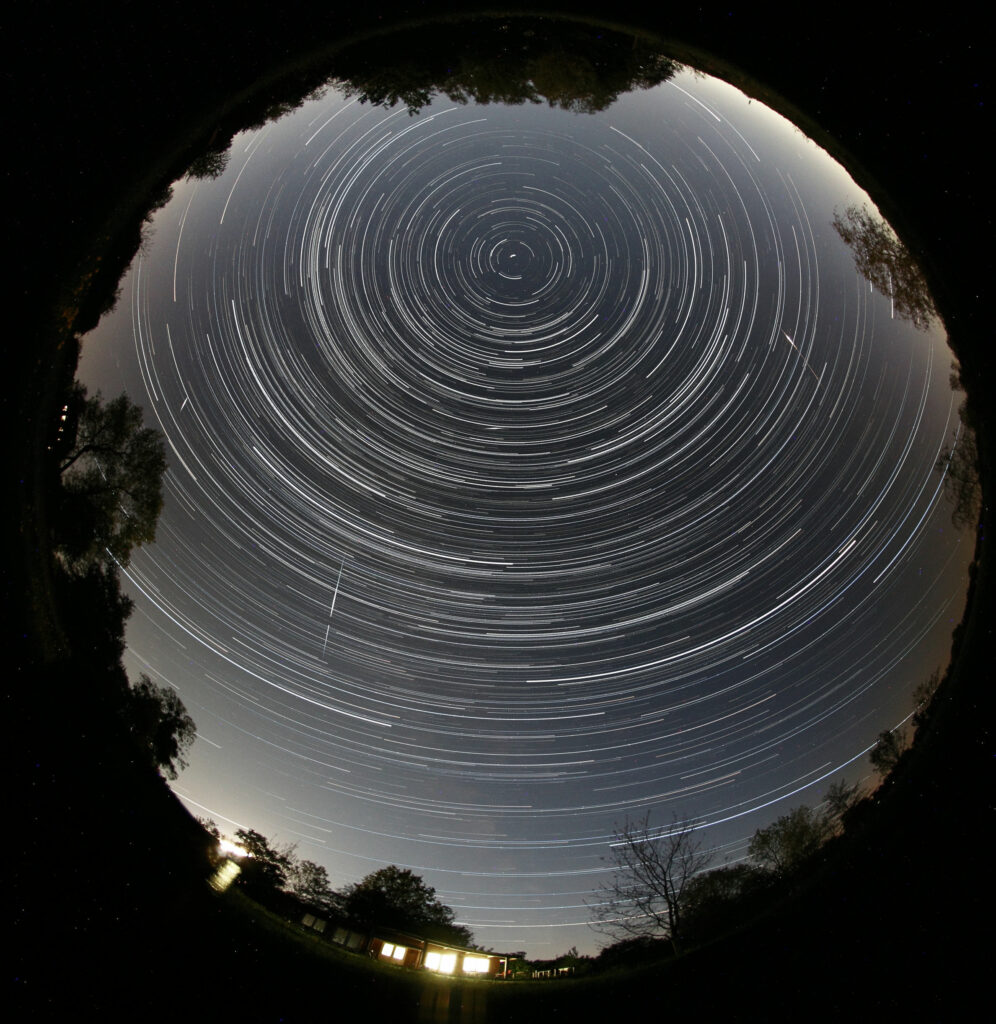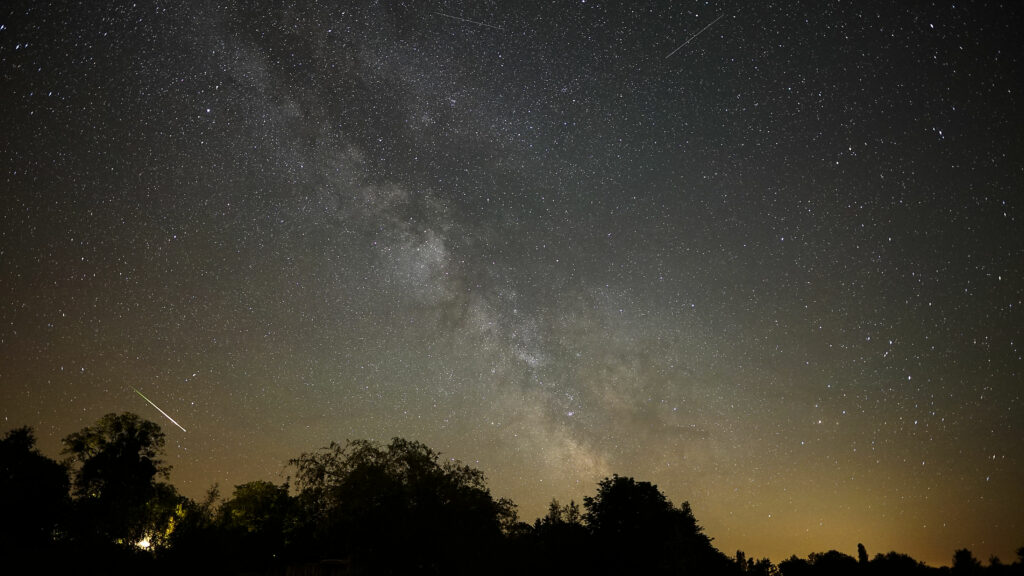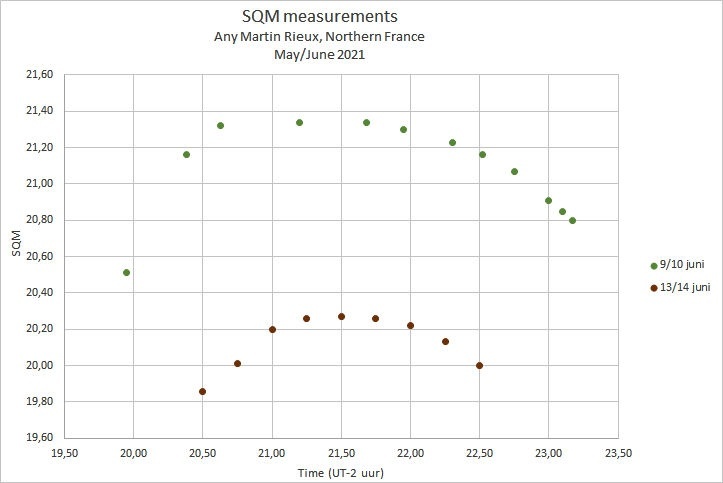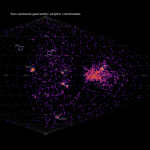Abstract:
Overview of visual meteor observations done by the author during spring 2021.
Introduction
The weather didn’t cooperate one bit during the autumn campaigns: no Leonids and Geminids were seen. Autumn 2020 was followed by a bad winter and spring season 2021. During the Bootids it was cloudy and so was the rest of January and February. During March there was some hope for clear weather but in the end it was disappointing. Only four sessions were the result, all for a maximum of 1.5 hours.
Then it was time to observe the Lyrids. First quarter moon on April 20 means moonlight all night long during the Lyrid maximum. Despite this, observations were scheduled for 21/22 and 22/23 and 23/24 April. But again, the weather let me down, only 16/17 and 17/18 April could be observed. The month of April was wet and much too cold compared to the long-term average temperatures. The same was true for May, this month was just as cold as April with a lot of rain. In addition, the corona pandemic raged through Europe at full speed. Lockdowns were reinforced and borders remained closed.
In February I decided to book a two-week holiday at the Bel Any gite in Any Martin Rieux in northern France. It was by no means certain whether we could actually go, but if the lockdowns were eased, we had at least booked something. Any Martin Rieux is located 11 km east of the town of Hirson in the Champagne-Ardennes region. At this location we rented a very spacious 2 persons house where also our 5 dogs are welcome. This is in a dark area. We were here before in October 2017 [1] and June 2018 [2], the best SQM I ever achieved here was on October 22, 2017 (SQM 21.6) under not yet optimal conditions. Observing was of course not a must, but if it was clear I could at least observe under good conditions. The last time I could observe under perfect sky conditions was in May 2019 from Buzancy, also in northern France [3]. And further, the region is very beautiful, sloping with alternating meadows and forests.

Figure 1: Our rented house in Any Martin Rieux, northern France.
Due to the disappointing weather in 2020 and early 2021, the pleasure of observing meteors visually had gradually taken a serious blow. I hoped to get the hang of it again in Any Martin Rieux. We took the actual decision whether to go or not to go mid-May. At that time, both Lizzie (fully) and I were (partly) vaccinated against corona. The owners of the cottage were also vaccinated. In addition, you actually already live there in quarantine as it is a very remote site.

Figure 2. Regular deep blue Provencal like skies at Any Martin Rieux. This is the view from the rented cottage.
The visual observations were made from a location left of the tree group.
Observing at Any Martin Rieux
We booked the gite for the period from May 29 to June 12. And in the week before departure, a switch to more stable and sunnier weather finally seemed to take place, exactly when we had our first day off. I got some equipment with me: the all-sky camera EN-908 (Canon 6D, Sigma 8 mm F 3.5 fish eye lens with a LC Shutter, the visual observing material (of course!) and a Sony A7s II with a battery of lenses. The Sony A7II camera was already purchased in March 2020 but has barely been used. This holiday was used to get to know this camera better.
May 29/30, 2021
As expected, the first night was already clear. After a short nap in the evening I got a good two-hour session. Longer was not possible due to the rising moon. The all-sky camera did run all night of course. In the Netherlands you can visually start around 22:15 UT during this time and continue until 01:00 UT at the most (Lm minimum 5.9). That is different in Any Martin Rieux, which is about 3 degrees more south than Ermelo. The observations can already start around 21:30 UT, the lm then reaches already 5.9. As time went on, the lm was rising to 6.65 and the SQM to 21.4. That’s as good as southern France. The starry sky was beautiful, especially the Milky Way was spectacular. This session started at 21:29 and ended two hours later at 23:31 UT. Meteors from the Antihelion radiant and tau Herculids were monitored. The two-hour effective yielded 23 meteors. No bright meteors but a lot of faint ones as can be expected in these conditions. A fast +2 SPO in Ophiuchus was the best meteor. At 22:59 UT, a short very slow +3 meteor has been seen in Serpens Caput and this appeared to be a good candidate for the tau Herculids moving out of the 2017 radiant position. Despite the lack of bright meteors, this was a nice session: a very clear starry sky really helps!
Incidentally, a lot of satellites were also seen, including a low ISS passage in the southwest. A flash of Mv-6 at 23:15 UT in Ursa Major was caused by a satellite. The temperature dropped this night to +3 at ground height. No satellite trains occurred this night, but sometimes satellites passed with exact the same trajectory, most likely Starlinks.
May 30/31, 2021
The sky turned into beautiful deep blue during the day, announcing a crystal-clear sky. I had chosen a place a little further away from the house so that the view was better with less obstruction. However, a few cows from the nearby meadow curiously came to see what I was doing. It went well, it was just a bit of booing and splashing…. Observations were done between 21:29 and 00:11 UT. The moon rose a little later than previous night. Thanks to the beautiful dark sky, 31 meteors were seen in 2.68 hours. Most of them were faint, but also a few bright meteors. 5 meteors were coming from the Antihelion source and again one possible tau Herculid! The most beautiful meteor was at the end of the session: a beautiful white slow magnitude 0 SPO meteor. This meteor appeared to be coming from the same area as the beautiful fireball captured with the all sky camera (May 31, 2021 at 01:44:25 UT). The nice sky in Any Martin Rieux is often accompanied by beautiful bird sounds, of which the call of the Jay and a number of owls is the most unusual. In addition, on the property there is a large pond with dozens of frogs that continue to croak all night. And sometimes you hear rustling in the high grass from rabbits or hedgehogs.

Figure 3: Startrails composition of the night May 30/31, 2021. Three bright satellites are visible, as well as the bright fireball of that night. The rising moon can also be seen at the bottom left. All sky camera EN-908. Camera: Canon 6D. Lens: Sigma 8 mm F 3.5 (diafragma set at 4.0) with built in Liquid Crystal Shutter set at 16 breaks per second.

Figure 4. Crop of the original all sky image of the fireball of May 31, 2021.
The fireball is simultaneous with the all sky stations in Wilderen (Jean Marie Biets), Oostkapelle (Klaas Jobse),
Benningbroek (Jos Nijland) and AstroLab Ieper (Franky Dubois).
Calculations on this fireball are already done by Hans Betlem (Dutch Meteor Society).
May 31/June 1, 2021
This night it was possible to observe a little longer. However, a slightly later start was made, which meant that there was effectively almost the same observation time as the previous night. Between 21:44 and 00:35 UT, 2.65 hours were observed and that resulted in 37 meteors, 6 of which were ANT and again a possible tau Herculid. A nice pair +2 and +1 ANT’s were the highlights. The sky was very transparant and dark. The Milky Way was fantastic to see, with the deep sky objects low to the south. SQM values rose to 21.45 and the limiting magnitude eventually to 6.7. This night I also used the Sony A7s II in combination with the Sigma ART 20 mm f/1.4 DG HSM E lens for the first time to take a series of images. The camera is actually intended for making high-quality video recordings, especially at night with low light. But the camera also does well with photography, as can be seen from the beautiful images that emerge.
June 1/2, 2021
This was another day with clear Provencal like skies. However, after the nap time, the sky quality appeared to have deteriorated. And low in the south, black spots were visible: clouds. Fortunately, this remained limited low on the horizon during the session. Only at the end of the session the clouds moved into my field of view. This would be the start of a period of more unstable weather.
Observations were done between 21:40 and 00:55 UT. 33 meteors were counted during 3.05 hours. A nice +2 ANT appeared in Scorpius. An even nicer +1 ANT moved slowly through Sagittarius. And a +3 ANT left a short persistent train in Aquila, which was also special! The most beautiful meteor was a +1 fast sporadic meteor with a 2 second persistent train in Ophiuchus. When I ended the session, Saturn and Jupiter were visible in the southeast. It was such a beautiful sight with those two planets near each other.
As mentioned, the weather changed after this night. That didn’t mean it got bad, but meteor observations were not possible due to cirrus clouds. On Friday, June 4, we had some fierce thunderstorms in the evening. However, it took until June 6/7 before anything could be done again. This night would be clear but because of a heavy hay fever attack resulting in watery and itchy eyes I could not observe. Afterwards it appeared from the all sky recordings that there were still too many clouds, so I hadn’t missed anything at all. The next night was clear:
June 7/8, 2021
During the day a beautiful deep blue sky led to another crystal-clear night. Despite the good transparency and darkness, it seemed that the sky background didn’t get as dark as, say, May 31/1 June. Perhaps I saw the difference here that the sun set a little less deeply during the night? Limiting magnitude was 6.6 maximum, SQM maximum was 21.40, see also figure xxx . Later in the night, some low fog banks formed in the adjacent meadows. Observations were done between 21:50 and 01:06 UT. In total I counted 28 meteors, and much to my surprise also this time I saw a candidate for the tau Herculids (+4). The most beautiful meteor appeared immediately at the start of the observations. A beautiful earth-grazing magnitude 0 ANT moved from Serpens Caput to Ursa Major! Another beautiful meteor was a +1 SPO which moved from Lyra to Bootes. The Sony A7s II made several videos of the starry sky this night. The ISO was set to 25000. The result was stunning and sharp images shot at 20mm F 1.6 and 25 fps. Limiting magnitudes for the camera with these settings were around 6. Several meteors were recorded, see also figure 5. All in all this was a successful night.

Figure 5. Video still of one of the meteors captured with the Sony A7 S II with the SIGMA 20MM F/1.4 DG HSM ART
The night June 8/9 was clear but with a lot of cirrus and fog banks in the morning. No visual observations were possible because of this.
June 9/10, 2021

Figure 6. During the evening of the 9th of June, Noctilucent Clouds (NLCs) were visible, photo taken with a Samsung smartphone.
This night was again very clear. When I inspected the sky to see Mars and Venus together around 20:50 UT I saw a tuft of illuminated cirrus clouds low north. Hmm, those looked like noctilucent clouds. I quickly walked to a place with a better view and saw several of the characteristic elongated clouds hanging in the northeast: Yes, these were NLCs. Not an extensive display, but the NLC low north was very bright. It is always fun to see this clouds in the summer month’s…
When I started the session, limiting magnitude reached 6.6 and SQM 21.40. And the air was now very dry. This is the maximum sky quality you can get in June at this location! Observations started at 21:55 and ended at 01:10 UT. In addition to the Antihelion and tau Herculids, fast meteors originating from Delphinus were also monitored. They are called gamma Delphinids, a meteorshower that had a strong outburst on the night of June 10/11, 1930.
The first hour started nicely with 4 Antihelions of which three appeared within 7 minutes and resp. +2, -1 and +2. Especially the -1 ANT was beautiful, low in the west this meteor moved right through Leo. Two minutes later another nice +2 appeared in Bootes.
Furthermore, 2 possible tau Herculids (!) were seen this night, the first one (+3) with a short path from Bootes to Corona Borealis. The second one was a slow magnitude 0 meteor in Virgo. However, I did see this one with a DCV of 50 degrees…. During 3.18 hours effective I counted 38 meteors, including 9 ANT, 2 possible tau Herculids and 1 gamma Delphinid (+4). The Sony A7s II took photos of meteors all night. Two were captured, including a -3 sporadic fireball on June 9, 2021 around 22:48 UT. This fireball was also captured (very weakly) with the all-sky camera and also on many AllSky7 stations in Western Europe.

Figure 7. This bright meteor of magnitude -3 was captured on June 9, 2021 at 21:48 UT.
Camera: Sony A7s II with a Sigma 20MM F/1.4 DG HSM ART, F 1.6, 10 sec at 4000 ISO. Single shot.
10/11 June 2021
This night was also completely clear, but it was a bust at the end. The strong winds blazing during the day persisted and so did the grass pollen that whirled around. As a result, I had to stop after 1.88 hours due to a heavy hay fever attack. Too bad, because I was curious about the gamma Delphinids. In the 90s I saw a few members of this obscure meteor shower. In total I counted 15 meteors of which 2 ANT and no gamma Delphinids.
The last night June 11/12 in Any Martin Rieux was also clear, but again with cirrus. So, no visual observations were possible. All in all, I had a nice holiday and observed a lot.
The night 13/14 June was clear in the Netherlands and so I did a two-hour session from Ermelo. Nice to be able to see the difference of a few degrees in latitude. Capella was clearly higher in the sky, while Antares was much lower. The sky background also remained much brighter with a maximum SQM of only 20.27 and Lm 6.2. In total, it was possible to watch for two hours between 22:30 and 00:32 UT, resulting in 10 meteors, 2 of which were ANT.

Table 1. Overview of the observations made at Any Martin Rieux, northern France.
SQM measurements in Any Martin Rieux.
In 2018 I obtained the SQM meter from the late Peter Bus [4] through Jaap van ‘t Leven. Since most of the clear nights in Any Martin Rieux made little difference in terms of brightness, I have put all measurements in a graph. The SQM measurements were plotted on a timeline containing time=UT-2 hours. This is because times after 0:00 UT are incorrectly displayed in the graph. Some interesting things can be learned from the graph.

Figure 8. All SQM observations from Any Martin Rieux, northern France.

Figure 9. SQM from the first four nights in which the moon was clearly a declining factor each night.

Figure 10. Difference in SQM measurements between the nights 31 May/1 June and 7/8 June 2021, the two nights with the highest transparency. Despite the fact that both nights had high transparency, the night of June 7/8 is slightly less in terms of sky background and SQM. Perhaps because the sun is less far below the horizon in the night 7/8 June compared to the night 31 May/1 June.

Figure 11. Difference SQM measurements between the night 9/10 June 2021 (Any Martin Rieux, northern France) and 13/14 June 2021 (Ermelo, The Netherlands). It is remarkable how much difference a few degrees in latitude shows.
Conclusion
We had a nice quiet holiday together and enjoyed the clear starry sky there. Effectively, meteors were observed for 18.58 hours, yielding 205 meteors. The all-sky camera scored 2 fireballs including a very nice one.
References
[1] Miskotte K., Orioniden vanuit Noord Frankrijk, eRadiant 2017-6, p. 143-145.
[2] Miskotte K., Midsummer nights 2018. Meteor observations at Any Martin Rieux, Northern France, Meteornews 2018-4, p. 201-203
[3] Miskotte K., Meteor observations from the very dark village Buzancy in northern France, Meteornews 2019-4, p. 241-243
[4] Miskotte K., Obituary: Peter Bus (1951-2016) , Meteornews 2016-2, p. 31.






